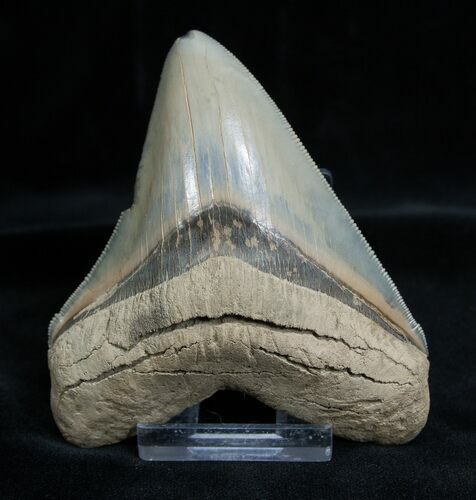This Specimen has been sold.
3.72" Carcharocles Chubutensis Transitional Tooth
This is an absolutely killer tooth that appears to represent a transitional species between Carcharocles chubutensis and Carcharocles megalodon. It's 3.71 inches in length, has a wonderful coloration pattern, and some great serrations. There is just a little bit of minor feeding damage to the tip. The cusp of the tooth is glossy and the bourrelette is in great shape. This was collected many years ago in Virginia near the Potomac River, a site that is now closed to collectors.
Carcharocles chubutensis is a terrifying prehistoric megatooth shark that lived roughly 28-5 million years ago. This formidable beast, estimated at 35-40 feet of jaw-snapping horror, shares infamy with the Megalodon. Its coexistence with Megalodon during the Miocene (23 mya) and Pliocene (5.3-1.7 mya) epochs, as well as similarities in their dentition, has brought about taxonomy debate worthy of this giant apex predator.
Like the Megalodon only smaller, C. chubutensis used serrated teeth to grab and rip apart fish, sea turtles, whales, and sirenids (sea cows). Habitat preferences may have changed through time, or C. chubutensis may have had enough behavioral flexibility to occupy different habitats as the ecology changed.
A prolific survivor, C. chubutensis stalked and shredded across the warmer reaches of the globe during the Oligocene, Miocene, and Pliocene. These epochs are marked by progressively developing icecaps and changes in ocean currents while tectonics aligned the continents to their modern positions.
The cartilaginous nature of the megatooth shark's skeleton limits fossil evidence to tooth morphology and some vertebral centra. Based on dentition, C. chubutensis is believed by many to be closely related to Megalodon and may have been a direct ancestor or a co-existing morpho-species. Its serrated transitional teeth suggest that of an ancient mackerel shark.
Otodus evolved from the Paleocene (65 mya) into the Carcharocles lineage. C. chubutensis teeth have two small cusps at the base of the tooth and are comparatively slender with a curved crown and feebly serrated lateral heels. Megalodon teeth generally have a straight edge from tip to base. However, commonality of teeth during growth further muddies the taxonomic waters.
Fossils of this species have been found in North America, South America, and Europe.
Like the Megalodon only smaller, C. chubutensis used serrated teeth to grab and rip apart fish, sea turtles, whales, and sirenids (sea cows). Habitat preferences may have changed through time, or C. chubutensis may have had enough behavioral flexibility to occupy different habitats as the ecology changed.
A prolific survivor, C. chubutensis stalked and shredded across the warmer reaches of the globe during the Oligocene, Miocene, and Pliocene. These epochs are marked by progressively developing icecaps and changes in ocean currents while tectonics aligned the continents to their modern positions.
The cartilaginous nature of the megatooth shark's skeleton limits fossil evidence to tooth morphology and some vertebral centra. Based on dentition, C. chubutensis is believed by many to be closely related to Megalodon and may have been a direct ancestor or a co-existing morpho-species. Its serrated transitional teeth suggest that of an ancient mackerel shark.
Otodus evolved from the Paleocene (65 mya) into the Carcharocles lineage. C. chubutensis teeth have two small cusps at the base of the tooth and are comparatively slender with a curved crown and feebly serrated lateral heels. Megalodon teeth generally have a straight edge from tip to base. However, commonality of teeth during growth further muddies the taxonomic waters.
Fossils of this species have been found in North America, South America, and Europe.
SPECIES
Carcharocles chubutensis
AGE
LOCATION
Potomac River, Virginia
FORMATION
Yorktown Formation
SIZE
3.72"
CATEGORY
SUB CATEGORY
ITEM
#1367
We guarantee the authenticity of all of our specimens.
 Reviews
Reviews













